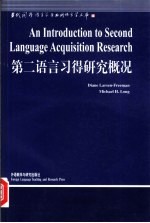

第二语言习得研究概况PDF电子书下载
- 电子书积分:14 积分如何计算积分?
- 作 者:(英)DianeLarsen-Freeman,(英)MichaelH.Long著蒋祖康导读
- 出 版 社:北京:外语教学与研究出版社
- 出版年份:2000
- ISBN:7560020100
- 页数:403 页
1 Introduction 1
1.1 The place of second language in the world today 1
1.2 Why study second language acquisition? 2
1.3 Development ofthe field of study ofsecond language acquisition 5
1.4 The scope ofsecond language acquisition research 6
Notes 7
Activities 8
Suggestions for further reading 9
2 Second language acquisition research methodology 10
2.2 Qualitative versus quantitative methodologies 10
2.1 Introduction 10
Preface by Hallday 11
Contents 11
王宗炎序 12
2.2.1 Introspection 15
2.2.2 Participant observation 15
导读 15
2.2.3 Non-participant observation 16
2.2.4 Focused description 17
2.2.5 Pre-experiment 19
2.2.6 Quasi-experiment 20
2.2.7 Experiment 20
2.3 Setting 24
2.4 Instrumentation:production data elicitation 26
2.5 Variability problem 30
2.6 Instrumentation:intuitional data elicitation 33
2.7 Instrumentation:use ofminiature languages 35
2.8 Instrumentation:affective variables 35
General Editor's Preface 36
2.9 Instruments from other disciplines 37
2.10 Measuring learner performance 38
2.10.1 Defining language proficiency 38
Authors'Preface F 39
2.10.2 Defining an acquisition point 40
2.10.3 Task versus test 41
2.10.4 An index ofdevelopment 42
Acknowledgements 42
2.11 Conclusion 44
Notes 45
Activities 46
Suggestionsforfurther reading 50
3 SLA:Typesofdataanalysis 52
3.1 Introduction 52
3.2 Contrastiveanalysis 52
3.2.1 The contrastive analysis hypothesis 53
3.2.2 Language acquisition as habit formation 55
3.2.3 The CAH refuted 55
3.3 Erroranalysis 56
3.3.1 Strong versus weak versions of the CAH 56
3.3.2 Language acquisition as rule formation 57
3.3.3 Interlingual versus intralingual errors 58
3.3.4 Interlanguage 60
3.3.5 Erroranalysis criticized 61
3.4 Performanceanalysis 62
3.4.1 Morpheme studies 62
3.4.2 Developmental sequence 63
3.4.3 Learner strategies 65
3.4.4 The acquisition offorms and functions 68
3.4.5 Formulaic utterances 68
3.5 Discourseanalysis 69
3.5.1 Conversational analysis 70
3.5.2 Other applications ofdiscourse analysis 71
3.6 Conclusion 73
Notes 74
Activities 75
Suggestionsforfurtherreading 80
4.2 ILs vary systematically 81
4.2.1 Freevariation 81
4.1 Introduction 81
4 Interlanguage studies:Substantive findings 81
4.2.2 Systematic variability 82
4.2.3 Variability resulting from amount of attention 84
4.2.4 Free variation as an impetus for development 85
4.2.5 Multiple explanations for variability 86
4.3 ILs exhibit common acquisition orders and developmental sequences 88
4.3.1 Acquisition order:morpheme studies 88
4.3.2 Developmental sequence:interrogatives 92
4.3.3 Developmental sequence:negation 94
4.4 ILs are influenced by the learner's L1 96
4.4.1 The effect of the L1 on SLA:how 97
4.4.2 The effect of the L1 on SLA:when(markedness) 101
4.4.3 The effect of the L1 on SLA:when(perceived transferability) 103
Notes 107
Activities 108
Suggestions for further reading 112
5 The linguistic environment for language acquisition 114
5.1 Linguistic input for first language acquisition 114
5.2 Linguistic input for second language acquisition 116
5.2.1 Linguistic adjustments to non-native speakers 117
5.2.2 Conversational adjustments to non-native speakers 120
5.3 Does the linguistic environment make a difference? 128
5.3.1 The effect of deviant input 129
5.3.2 The role of conversation in developing syntax 130
5.3.3 Input frequency-accuracy order relationships 132
5.3.4 Input modification and second language comprehension 134
5.3.5 Comprehensible input and second language acquisition 139
Notes 144
Activities 145
Suggestions for further reading 152
6.1 Introduction 153
6 Explanations for differential success among second language learners 153
6.2 Age 154
6.2.1 Studies of age and SLA 155
6.2.2 Explanations for age-related differences 163
6.3 Aptitude 167
6.4 Social-psychological factors 172
6.4.1 Motivation 173
6.4.2 Attitude 175
6.5 Personality 184
6.6 Cognitive style 192
6.7 Hemisphere specialization 197
6.8 Learning strategies 199
6.9 Otherfactors 203
6.10 Conclusion 206
Notes 215
Activities 216
Suggestions for further reading 218
7 Theories in second language acquisition 220
7.1 Introduction 220
7.2.1 The role oftheories in making research cumulative 221
7.2 Theory construction and social science 221
7.2.2 Purposes and types oftheory 222
7.3 Nativist theories ofSLA 227
7.3.1 General characteristics 227
7.3.2 Chomsky's Universal Grammar and SLA 228
7.3.3 A critique of language-specific nativist theories 235
7.3.4 Krashen's Monitor Theory 240
7.3.5 A critique ofMonitor Theory 245
7.4.1 General characteristics 249
7.4 Environmentalist theories of SLA 249
7.4.2 Schumann's Pidginization Hypothesis and Acculturation Model 251
7.4.3 A critique of the Pidginization Hypothesis and Acculturation Model 258
7.5 Interactionist theories of SLA 266
7.5.1 General characteristics 266
7.5.2 Givon's Functional-Typological Theory and SLA 267
7.5.3 A critique ofGivon's theory in SLA research 269
7.5.4 The ZISA's group's Multidimensional Model 270
7.5.5 A critique ofthe Multidimensional Model 283
7.6 Conclusion:the state of SLA theories 287
7.6.1 Comparing and evaluating theories 287
7.6.2 A note of caution 289
Notes 290
Activities 293
Suggestions for further reading 296
8 Instructed second language acquisition 299
8.1 Introduction 299
8.2 Early research on the effect ofinstruction,and some claimed implications 300
8.3 The effect of instruction on accuracy orders and developmental sequences 304
8.4 The effect of instruction on acquisition processes 309
8.5 The effect of instruction on rate ofacquisition 312
8.6 The effect of instruction on the level ofultimate SL attainment 315
8.7 Conclusion 321
8.8 Explanations 322
8.9 Researching instructional design features 325
Notes 327
Activities 328
Suggestions for further reading 330
Epilogue 332
Bibliography 334
Index 394
文库索引 399
- 《红色旅游的社会效应研究》吴春焕著 2019
- 《汉语词汇知识与习得研究》邢红兵主编 2019
- 《生物质甘油共气化制氢基础研究》赵丽霞 2019
- 《东北民歌文化研究及艺术探析》(中国)杨清波 2019
- 《联吡啶基钌光敏染料的结构与性能的理论研究》李明霞 2019
- 《异质性条件下技术创新最优市场结构研究 以中国高技术产业为例》千慧雄 2019
- 《《国语》和《战国策》词汇比较研究》陈长书著 2017
- 《中国制造业绿色供应链发展研究报告》中国电子信息产业发展研究院 2019
- 《行政保留研究》门中敬著 2019
- 《新课标背景下英语教学理论与教学活动研究》应丽君 2018
- 《古代巴比伦》(英)莱昂纳德·W.金著 2019
- 《BBC人体如何工作》(英)爱丽丝.罗伯茨 2019
- 《一个数学家的辩白》(英)哈代(G.H.Hardy)著;李文林,戴宗铎,高嵘译 2019
- 《莎士比亚全集 2》(英)莎士比亚著,朱生豪等译 2002
- 《莎士比亚戏剧精选集》(英)威廉·莎士比亚(William Shakespeare)著 2020
- 《莎士比亚 叙事诗·抒情诗·戏剧》(英)威廉·莎士比亚著 2019
- 《亚历山大继业者战争 上 将领与战役》(英)鲍勃·本尼特,(英)麦克·罗伯茨著;张晓媛译 2019
- 《孩子们的音乐之旅 1 宝宝睡觉 幼儿版》包菊英主编 2016
- 《超级参与者》王金强责编;赵磊译者;(澳)杰里米·海曼斯,(英)亨利·蒂姆斯 2020
- 《物联网导论》张翼英主编 2020
